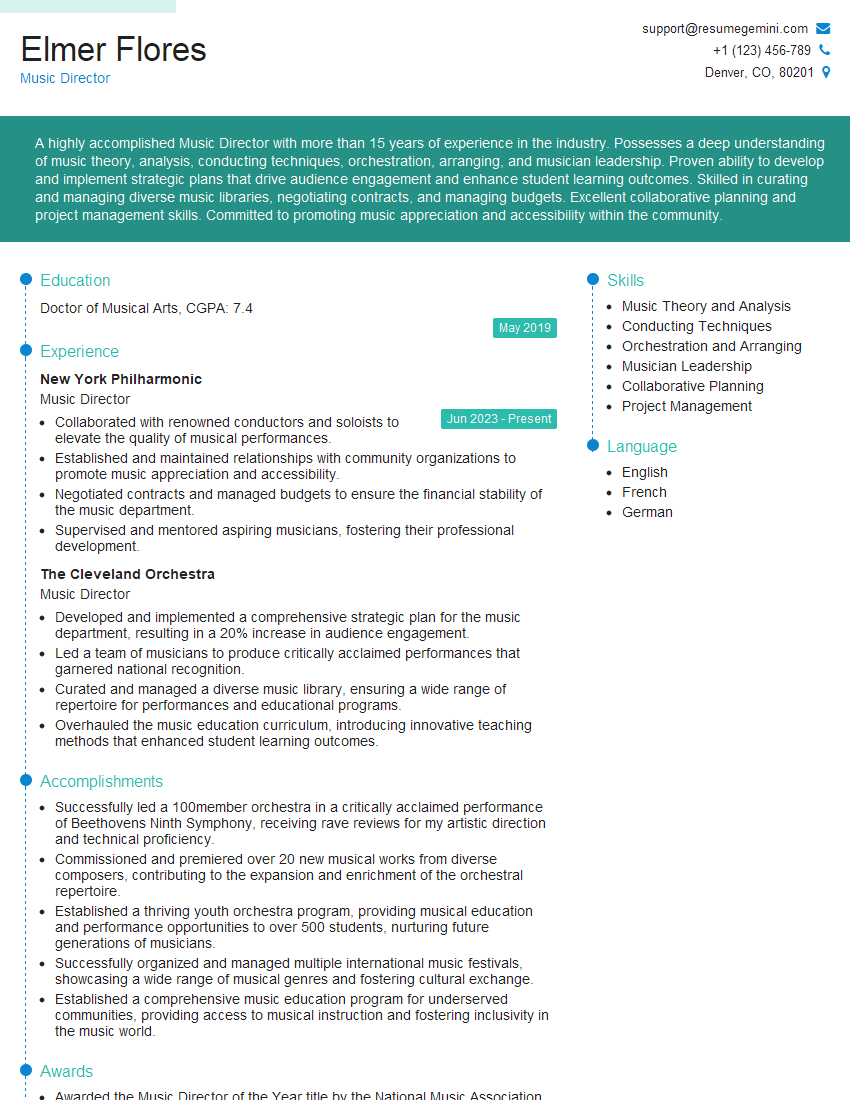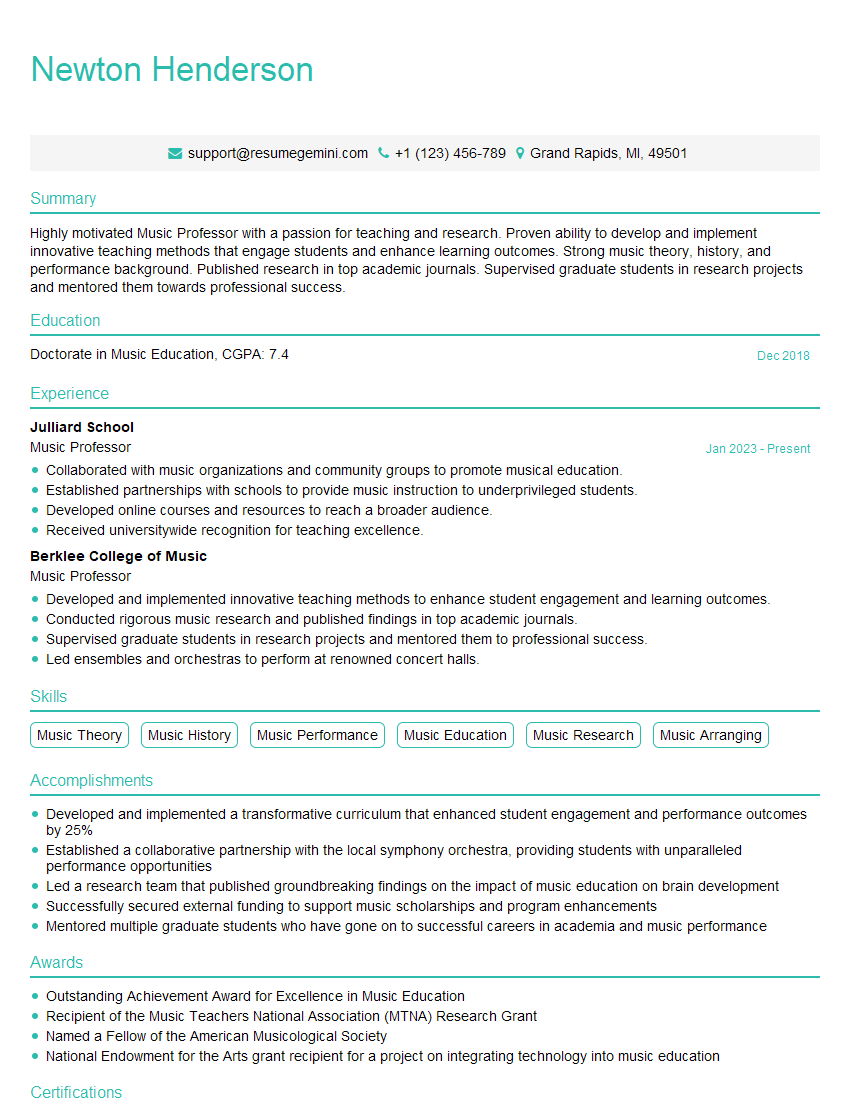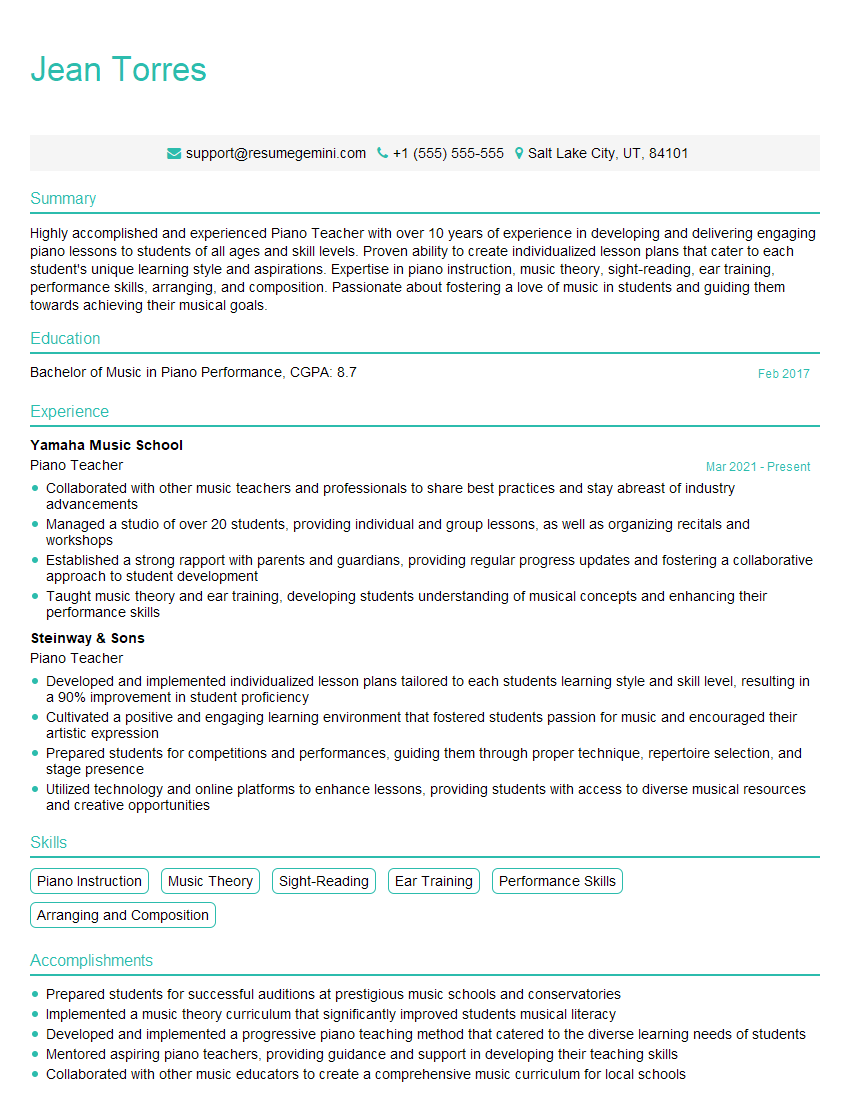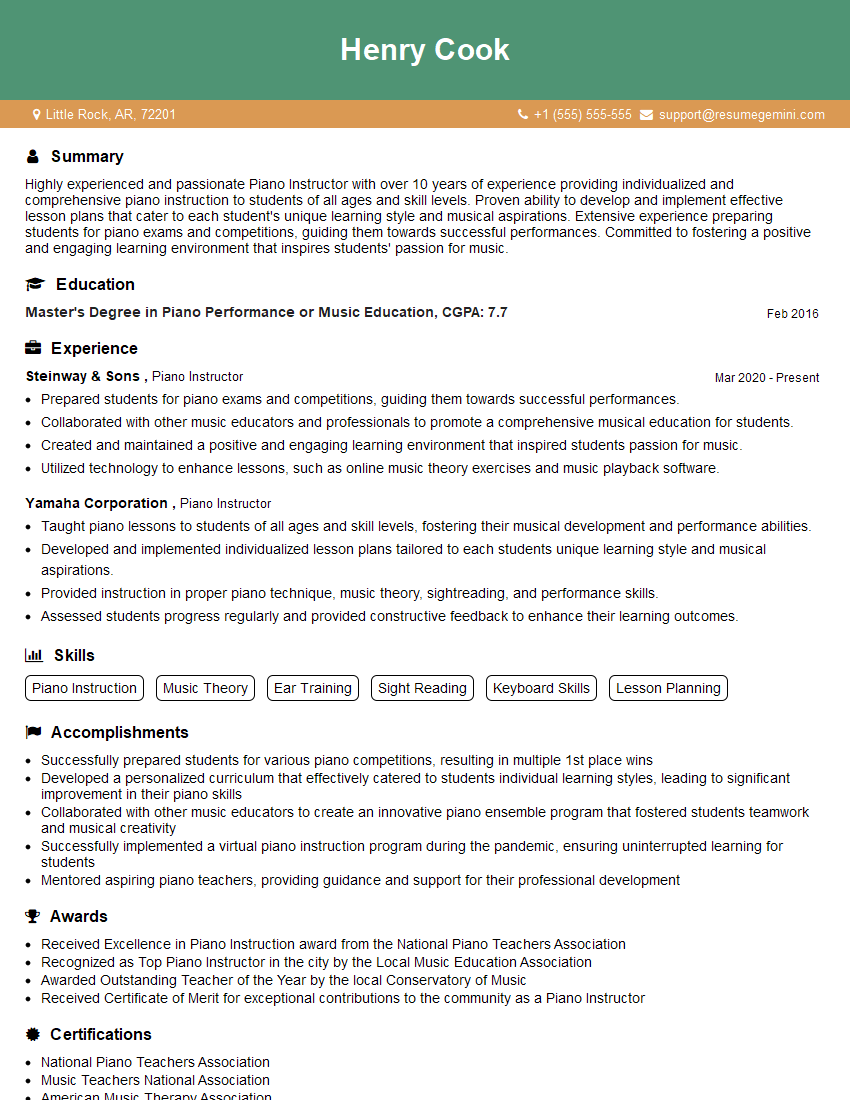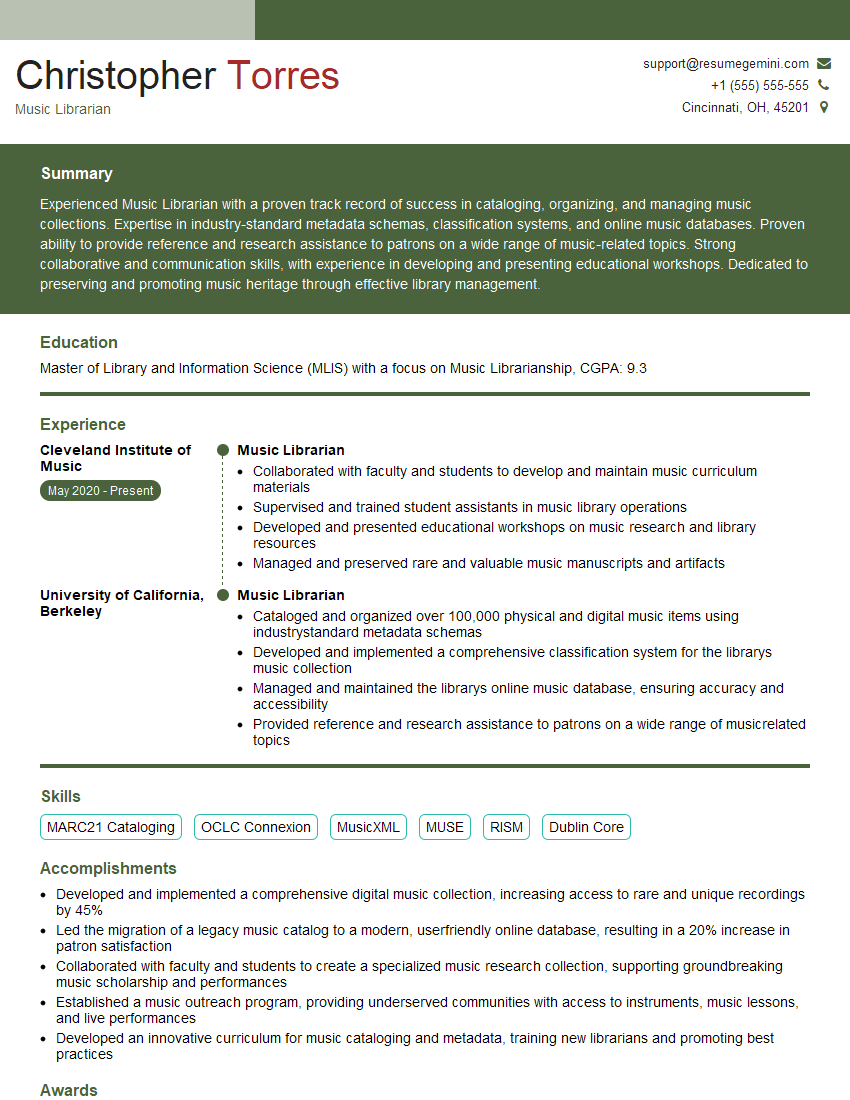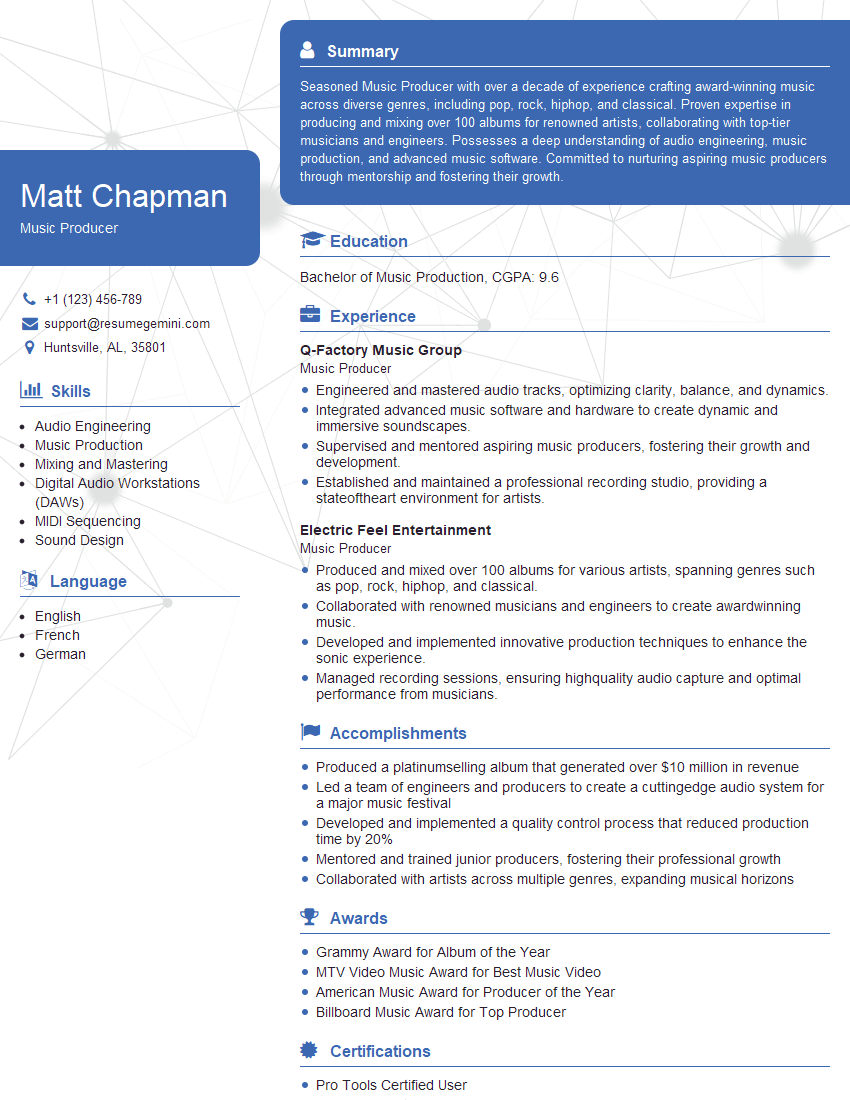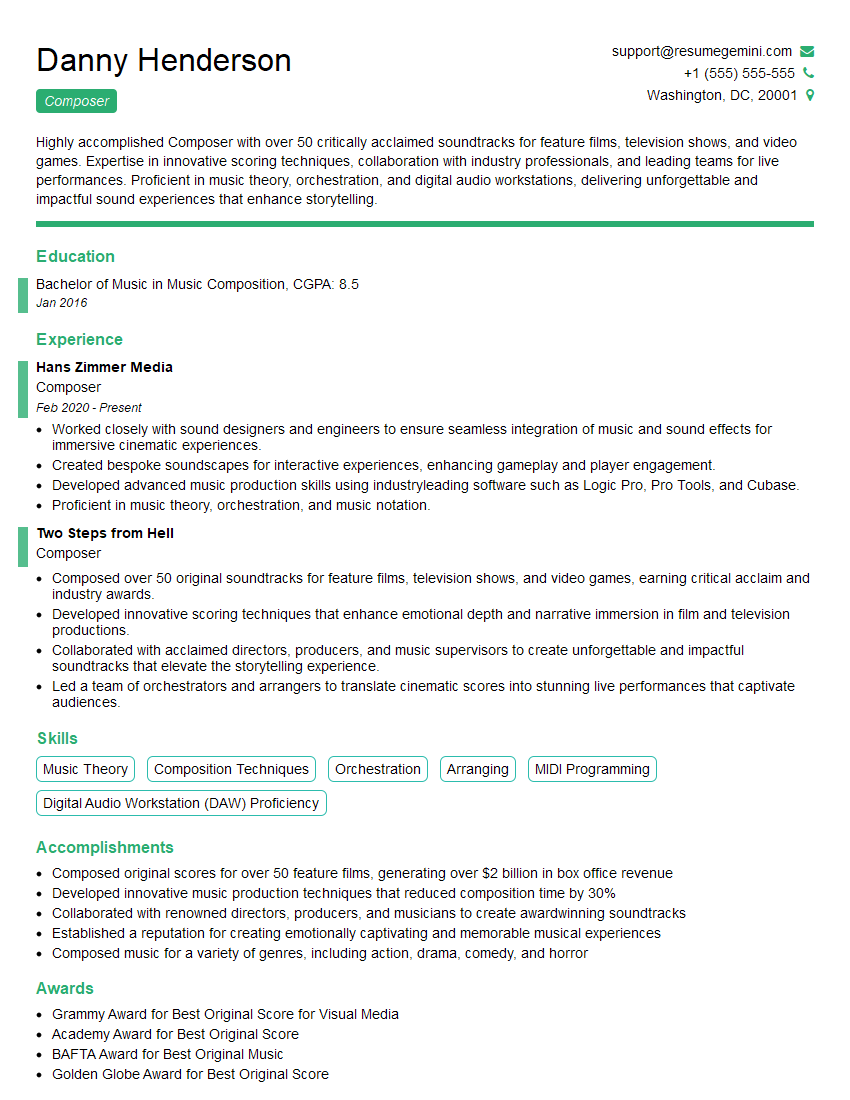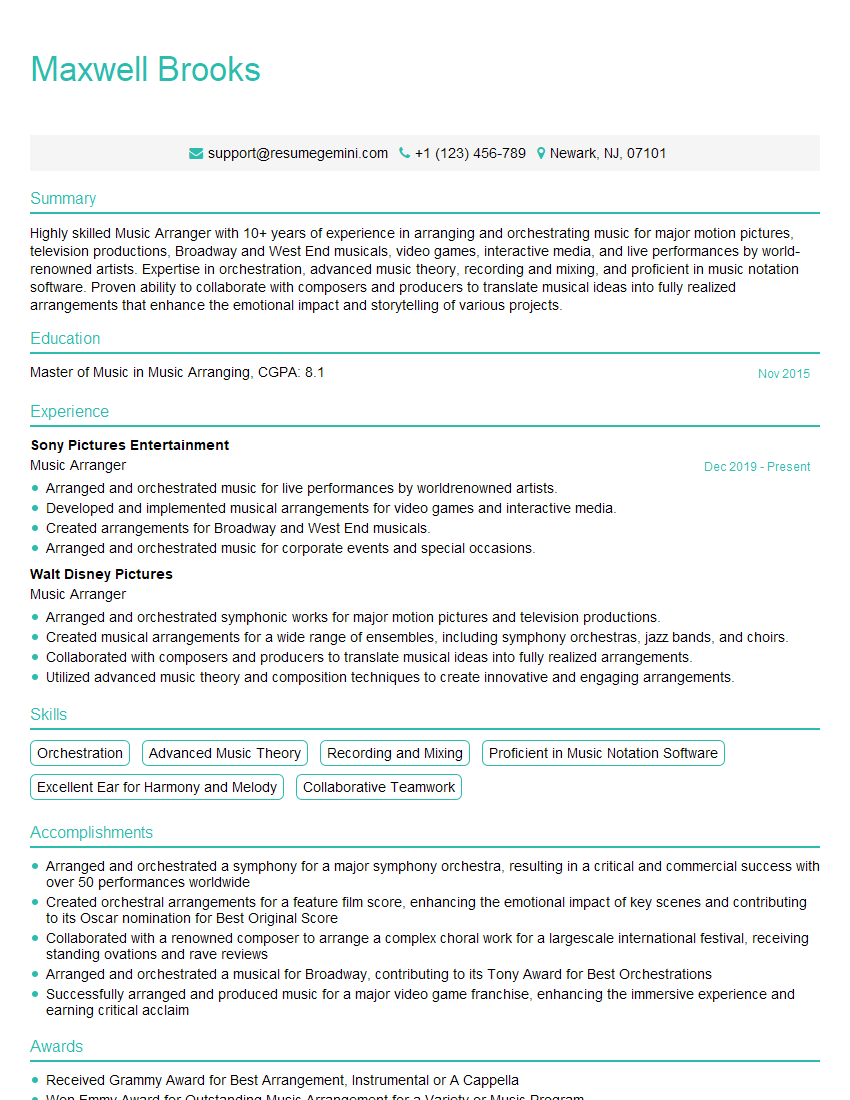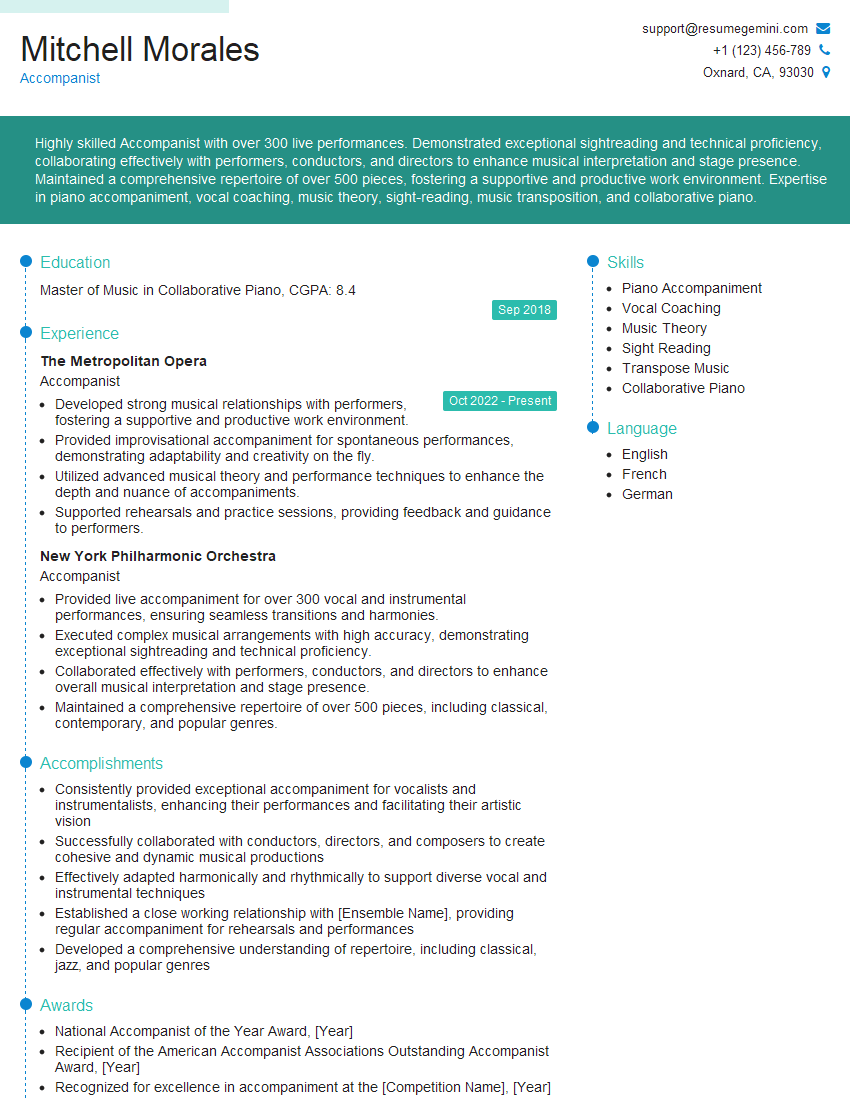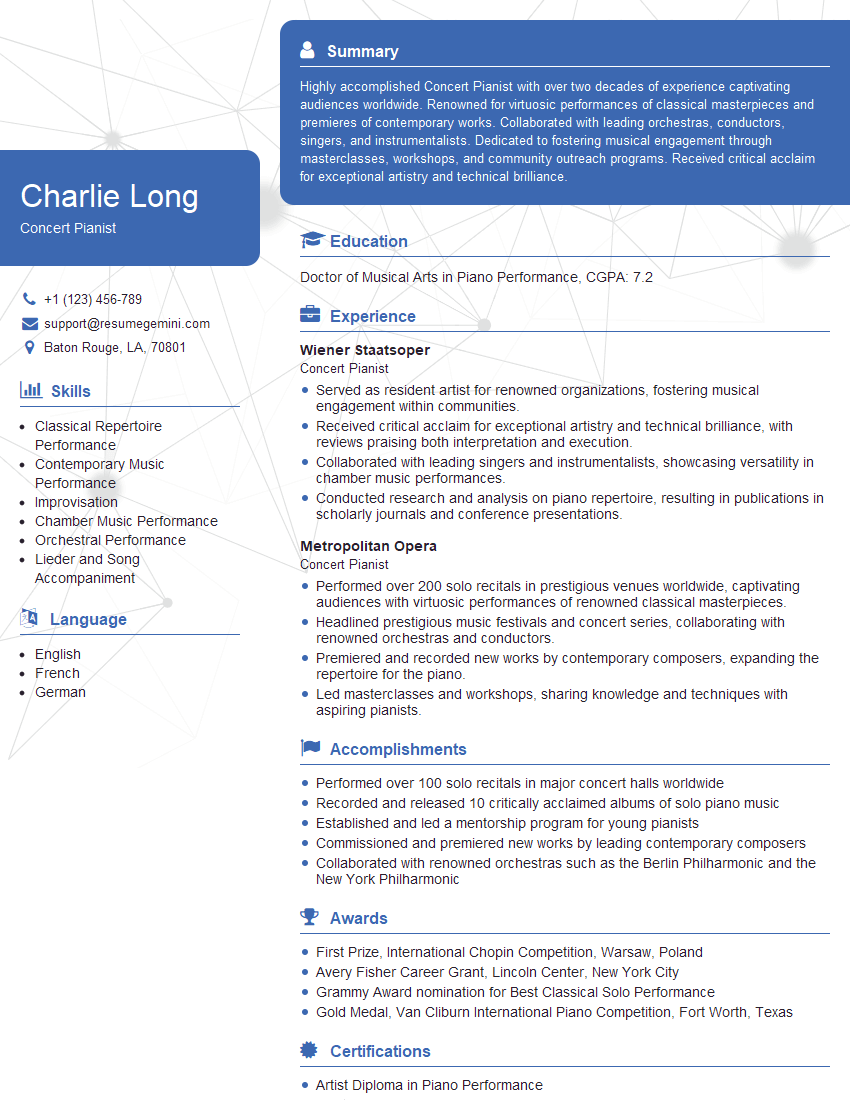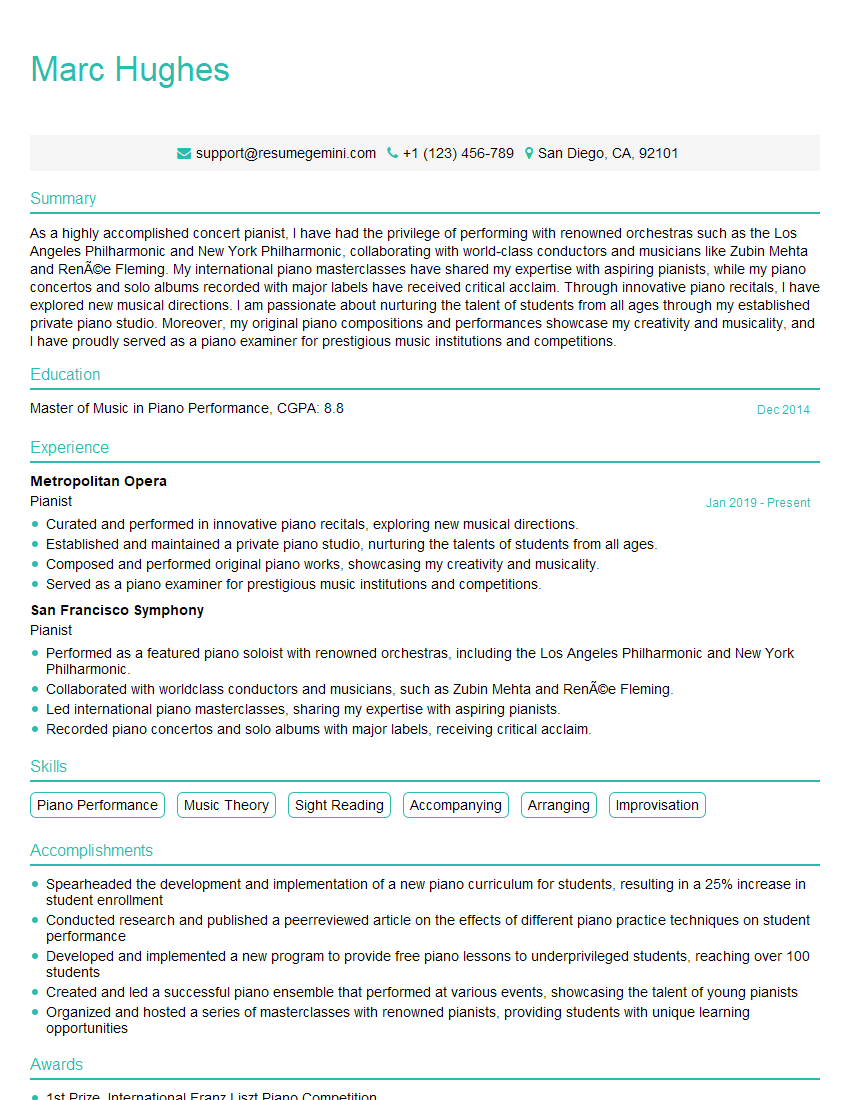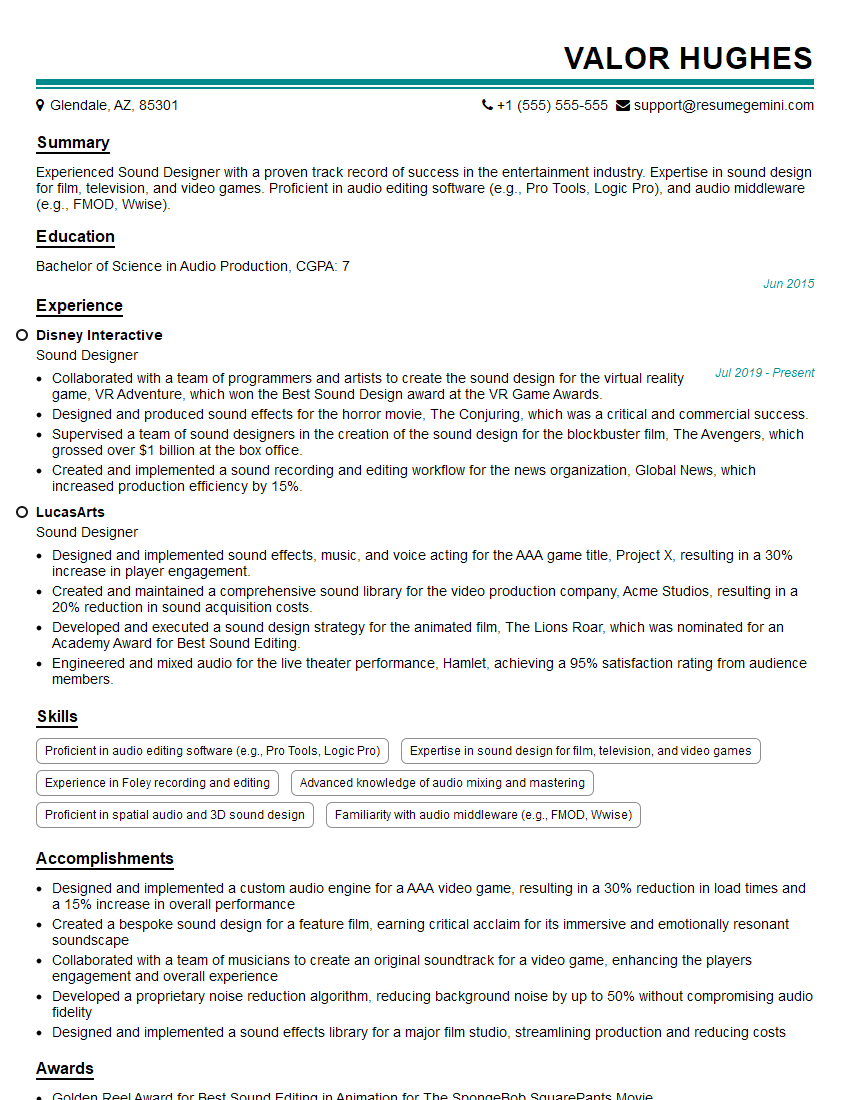Interviews are opportunities to demonstrate your expertise, and this guide is here to help you shine. Explore the essential Piano Performance and Composition interview questions that employers frequently ask, paired with strategies for crafting responses that set you apart from the competition.
Questions Asked in Piano Performance and Composition Interview
Q 1. Explain your approach to practicing a technically challenging piano piece.
Tackling a technically demanding piano piece requires a methodical, multi-stage approach. It’s not just about playing the notes; it’s about mastering the intricacies of the music. I begin by meticulously dissecting the piece, identifying the most challenging passages. This might involve sections with rapid arpeggios, complex chord progressions, or intricate ornamentation.
Slow Practice: I start by practicing these difficult passages at a significantly slower tempo than the indicated tempo. This allows for focused attention on accuracy and evenness. I often break down complex passages into smaller, manageable units, working on each section until it is flawlessly executed at the slow tempo.
Hand Separation: If coordination between the hands is a challenge, I practice each hand separately, focusing on developing individual fluency. Only once both hands are comfortable do I combine them. Gradually, I increase the tempo, ensuring accuracy remains consistent.
Mental Rehearsal: Mental practice is crucial. I visualize myself playing the passage flawlessly, paying attention to finger placement, articulation, and dynamics. This mental rehearsal strengthens muscle memory and improves performance under pressure.
Recording and Analysis: Recording myself allows for objective self-assessment. I listen back critically, identifying any inconsistencies in rhythm, tempo, dynamics, or articulation. This provides valuable insights that guide my subsequent practice sessions.
Gradual Tempo Increase: I gradually increase the tempo, only moving to the next level when the previous one is played consistently and accurately. This prevents the development of bad habits from rushing the process.
For example, when tackling Rachmaninoff’s notoriously difficult Piano Concerto No. 3, I spent weeks working on just the cadenza sections, employing all of these techniques before combining them with the rest of the piece.
Q 2. Describe your experience with different compositional styles (e.g., Baroque, Classical, Romantic, Modern).
My compositional experience spans various historical periods, each requiring a distinct approach.
Baroque: Composing in the Baroque style necessitates a strong understanding of counterpoint, fugue writing, and the use of ornamentation. I focus on creating clear melodic lines and intricate harmonic structures, often employing terraced dynamics and basso continuo.
Classical: The Classical period emphasizes clarity, balance, and formal structure. My compositions in this style adhere to established forms like sonata form and theme and variations, prioritizing elegant melodies and homophonic textures.
Romantic: Romantic compositions are characterized by expressive melodies, dramatic harmonies, and rich orchestration. I focus on evoking emotion and creating a sense of drama, utilizing rubato (flexible tempo) and expansive harmonic progressions.
Modern: Modern composition is far more experimental. I’ve explored atonal and serial techniques, incorporating elements of dissonance and unexpected harmonic shifts, moving away from traditional tonal structures. This style demands creative exploration of rhythm, timbre, and form.
Each style presents unique challenges and opportunities. The process of navigating these diverse styles has honed my understanding of musical structure, harmony, and expression.
Q 3. How do you handle performance anxiety?
Performance anxiety is a common experience for musicians, and I’ve developed several strategies to manage it.
Thorough Preparation: The most effective method is meticulous preparation. Knowing the music inside and out dramatically reduces anxiety. This includes not just technical proficiency, but also a deep understanding of the musical narrative and emotional content.
Mindfulness and Meditation: Practicing mindfulness and meditation techniques helps me center myself before a performance. These techniques cultivate calmness and reduce negative thoughts.
Visualization: I visualize myself performing successfully, focusing on the positive aspects of the experience. This mental rehearsal builds confidence and reduces the fear of failure.
Controlled Breathing: Deep, controlled breathing exercises regulate heart rate and calm the nervous system, helping to alleviate physical symptoms of anxiety.
Positive Self-Talk: Replacing negative self-talk with positive affirmations helps build self-belief and confidence. I remind myself of my skills and preparation.
Furthermore, performing in smaller, less formal settings beforehand helps to desensitize me to the nerves of performing in front of an audience.
Q 4. What software or technology do you use for music composition?
I primarily use Sibelius for music notation and composition. It’s a powerful software that allows for precise notation, score editing, and audio playback. I also utilize Logic Pro X for audio production and mixing. This allows me to experiment with different sounds and create detailed audio mock-ups of my compositions.
These tools help bring my musical ideas to life and offer valuable assistance in shaping the final product. The collaborative features within Sibelius have also proved invaluable for projects with fellow composers.
Q 5. Discuss your experience with sight-reading music.
Sight-reading is a fundamental skill for any musician, and I’ve cultivated a strong proficiency through consistent practice. My approach involves:
Understanding the Context: I first scan the music to understand the overall structure, key, time signature, and dynamic markings. This provides a framework for interpretation.
Focusing on Phrases: I read and play in small phrases, rather than trying to absorb the whole piece at once. This allows for focused attention and prevents mistakes from accumulating.
Identifying Key Elements: I pay close attention to melodic contour, harmonic progressions, and rhythmic patterns, using these as anchors to navigate the music.
Regular Practice: Consistent sight-reading practice is essential. I regularly work through unfamiliar pieces, gradually increasing in difficulty.
Sight-reading is a skill that improves with consistent practice; it’s not an innate ability, but one that is honed over time. I often use study scores of orchestral works to maintain this skill.
Q 6. Explain your understanding of music theory, including harmony, counterpoint, and form.
A solid understanding of music theory is the bedrock of both performance and composition.
Harmony: I understand harmonic functions (tonic, dominant, subdominant), chord progressions, voice leading, and various harmonic styles (e.g., common practice period, modern atonality). This knowledge informs my interpretations and compositions, allowing me to create coherent and expressive musical structures.
Counterpoint: Counterpoint is the art of combining independent melodic lines. I’m proficient in writing two-part, three-part, and more complex contrapuntal textures, understanding concepts such as imitation, inversion, and canon. This skill is essential for creating rich and interesting musical textures, especially in Baroque and Classical styles.
Form: Understanding musical form—such as sonata form, rondo form, theme and variations—is crucial for both performing and composing. I can analyze and interpret different forms, and use them effectively in my own compositions, creating pieces that are both aesthetically pleasing and structurally sound.
Music theory isn’t just abstract knowledge; it’s a practical tool that enhances musical understanding, interpretation, and creative expression.
Q 7. How do you incorporate improvisation into your performances or compositions?
Improvisation plays a significant role in both my performances and compositions.
Performance: In performance, I incorporate improvisation subtly, often by embellishing or extending melodic lines or adding ornamentation within the framework of the original composition. This allows for a personalized interpretation that adds spontaneity and expressiveness. For example, in a jazz context, improvisation might involve creating a solo based on the chord changes of a standard tune.
Composition: Improvisation is also a crucial tool in my composition process. I often begin with improvisational explorations at the piano, capturing musical ideas as they emerge. This spontaneous approach generates fresh material that I later refine and develop into a formal composition. These initial improvisations often provide the basis for melodies, harmonic progressions, and rhythmic ideas.
Improvisation fosters creativity and allows for a more intuitive and expressive approach to both performance and composition, while still respecting the original structure and intent of the music.
Q 8. Describe your process for composing a piece, from initial idea to final product.
My compositional process is iterative and deeply personal, but generally follows these steps. It begins with a spark – a melodic fragment, a rhythmic idea, or even a mood or emotion. I’ll spend time developing this initial germ, often at the piano, exploring its possibilities. This exploration might involve improvising variations, experimenting with different harmonies, or sketching out potential formal structures. I then begin a more formal notational process, usually using music notation software, where I flesh out the melodic and harmonic ideas, adding counterpoint, texture, and dynamic markings. This stage involves a lot of refining and revision; I’ll frequently step away from the score for a day or two to return with fresh ears. Once a draft is complete, I’ll seek feedback from trusted colleagues or mentors. This crucial step often leads to further revisions and adjustments before arriving at a final version, which is then prepared for performance or publication. For instance, my recent piece, ‘Nocturne in Eb Minor,’ started with a simple, melancholic melody that blossomed into a complex work with multiple interwoven themes over several months of development.
Q 9. What are your strengths and weaknesses as a pianist?
My strengths as a pianist lie in my technical proficiency and expressive capabilities. Years of dedicated practice have given me a solid foundation in scales, arpeggios, and advanced techniques. I’m particularly comfortable with complex polyrhythms and rapid passagework. My expressive playing, I believe, is my greatest asset; I strive to convey the full emotional range of a piece through nuanced dynamics, phrasing, and articulation. However, I recognize my weaknesses. While my technical skills are strong, I’m always seeking to refine my dexterity and stamina for even greater control and endurance. Another area I’m continuously working on is my ability to maintain a consistent level of energy and focus during particularly demanding performances.
Q 10. How do you adapt your playing style to different musical genres?
Adapting my playing style to different genres involves a deep understanding of the stylistic conventions of each genre. For example, playing a Baroque sonata requires a different approach than performing a contemporary minimalist piece. In Baroque music, I emphasize clarity of articulation, ornamentation, and a sense of rhythmic drive. In contrast, a minimalist piece may require a more subdued, spacious approach, focusing on timbre and subtle dynamic shifts. I achieve this adaptation through careful study of the score, listening to recordings by leading interpreters in each style, and a willingness to experiment with different approaches to touch, phrasing, and pedaling. For instance, playing ragtime requires a crisp, percussive touch, whereas playing romantic era pieces often calls for a more legato and lyrical approach.
Q 11. Explain your understanding of musical dynamics and articulation.
Musical dynamics and articulation are fundamental elements of musical expression. Dynamics refer to the loudness or softness of a sound, often indicated by terms like piano (soft), forte (loud), crescendo (gradually getting louder), and diminuendo (gradually getting softer). Articulation refers to how individual notes or groups of notes are played, affecting their character and expression. Common articulation markings include staccato (short, detached notes), legato (smooth, connected notes), and marcato (emphasized notes). The effective use of dynamics and articulation brings a piece to life. For example, a gradual crescendo leading to a powerful fortissimo can build tension and excitement, while a series of staccato notes can create a sense of energy and dance-like rhythm. A skilled pianist carefully considers both elements throughout a piece, tailoring them to the composer’s intentions and their own artistic interpretation.
Q 12. How do you approach the interpretation of a musical score?
My approach to interpreting a musical score is multifaceted. It begins with a thorough understanding of the historical context of the piece, including the composer’s life and the stylistic conventions of the period. Then, I carefully study the score itself, analyzing the melodic, harmonic, and rhythmic structures, along with dynamic and articulation markings. I spend significant time practicing, gradually building speed and accuracy, while constantly focusing on the expression and character of the music. I explore different interpretations, seeking to uncover the emotional depth and underlying meaning within the music. I might listen to various recordings by other musicians, but I strive to create my own unique interpretation, reflecting my understanding and sensitivity to the work. For example, in interpreting a Beethoven sonata, I might focus on the dramatic contrasts and intellectual depth of the piece, while in a Chopin nocturne I might emphasize the lyrical beauty and emotional intimacy.
Q 13. Discuss your experience working collaboratively with other musicians.
Collaborative work is a vital part of my musical life. I’ve had the pleasure of working with various musicians, including string quartets, vocalists, and other instrumentalists. These collaborations have taught me the importance of active listening, mutual respect, and a shared artistic vision. Successful collaboration requires clear communication and a willingness to compromise. It’s about finding a balance between individual contributions and creating a unified whole. For example, in a recent collaboration with a string quartet, we spent several rehearsals refining the balance between piano and strings, ensuring that each part was heard clearly and that the overall texture was well-integrated. The result was a much richer and more nuanced performance than I could have achieved alone.
Q 14. Describe your experience teaching or mentoring students.
My experience teaching and mentoring students has been incredibly rewarding. My approach is personalized, focusing on each student’s individual needs and goals. I begin by assessing their technical skills and musical understanding. Then, we work together to develop a practice plan that addresses their strengths and weaknesses. I emphasize the importance of consistent practice, careful attention to detail, and expressive playing. Beyond technical skills, I encourage my students to develop their musicality, critical thinking, and artistic expression. I believe that effective teaching involves building a strong rapport with students, creating a supportive learning environment, and inspiring them to reach their full potential. I’ve seen firsthand how patience, encouragement, and a focus on individual progress can empower students to achieve remarkable growth and confidence.
Q 15. How do you stay current with the latest trends in music composition and performance?
Staying current in the dynamic world of music requires a multifaceted approach. It’s not just about listening to the latest charts; it’s about actively engaging with the evolving landscape of composition and performance.
Active Listening and Exploration: I regularly listen to new releases across various genres, attending concerts and festivals to experience live performances and gain inspiration from diverse musical styles. This includes seeking out lesser-known composers and exploring experimental music scenes.
Following Industry Publications and Blogs: I subscribe to music magazines, both print and digital, and follow influential blogs and online publications that cover contemporary music trends, innovations in technology, and insightful commentary on performance practices. This keeps me informed about new techniques, software, and theories.
Networking and Collaboration: Attending conferences, workshops, and masterclasses allows me to engage with other composers and performers, share ideas, and learn from their experiences. This exchange of knowledge is invaluable for staying at the forefront of creative development.
Engaging with Academic Research: I regularly read scholarly articles and books on music theory, composition techniques, and performance pedagogy. This deepens my theoretical understanding and allows me to apply cutting-edge research to my own work.
Career Expert Tips:
- Ace those interviews! Prepare effectively by reviewing the Top 50 Most Common Interview Questions on ResumeGemini.
- Navigate your job search with confidence! Explore a wide range of Career Tips on ResumeGemini. Learn about common challenges and recommendations to overcome them.
- Craft the perfect resume! Master the Art of Resume Writing with ResumeGemini’s guide. Showcase your unique qualifications and achievements effectively.
- Don’t miss out on holiday savings! Build your dream resume with ResumeGemini’s ATS optimized templates.
Q 16. What is your preferred method for composing: notation software, piano, or other?
My compositional process is highly iterative and often involves a blend of approaches. While I find the immediacy of the piano invaluable for initial sketching and exploration of ideas, I ultimately rely on notation software for the detailed orchestration and refinement of my compositions.
I usually begin by improvising at the piano, capturing the essence of a melody or harmonic progression. This spontaneous process allows me to explore different ideas without the constraints of notation. I then meticulously transfer these initial sketches into notation software, such as Sibelius or Dorico, which allows for precise control over dynamics, articulation, and orchestration. This digital environment enables me to experiment with different instrumental combinations, refine the harmonic structure, and create a polished final score.
The piano acts as my initial creative playground, while the notation software serves as the precision instrument for realizing the full potential of my compositional vision.
Q 17. Explain your familiarity with different types of musical notation.
My familiarity with musical notation extends beyond the standard Western notation system. I have a thorough understanding of various historical and contemporary notational practices, which is crucial for both performance and composition.
Standard Western Notation: This forms the foundation of my understanding, encompassing traditional staff notation, clef signs, key signatures, time signatures, and rhythmic notation. I’m proficient in interpreting and transcribing complex scores.
Tablature (Tab): Primarily used for fretted instruments like guitar and lute, I have experience reading and writing tablature, allowing me to work effectively with musicians specializing in these instruments.
Computer-Assisted Notation Software: My proficiency includes utilizing software such as Sibelius and Dorico, which offer advanced features for notation, scoring, and audio playback, significantly enhancing my compositional efficiency.
Microtonal Notation: I understand the principles of microtonal music and various notational systems for representing intervals smaller than a semitone, expanding my compositional palette beyond the limitations of traditional 12-tone equal temperament.
Understanding diverse notational systems allows me to engage with a broader range of musical styles and collaborate effectively with musicians from diverse backgrounds.
Q 18. How do you manage your time effectively during rehearsals and performances?
Effective time management during rehearsals and performances is paramount. It’s about strategic planning and efficient execution. My approach centers around meticulous preparation and focused practice.
Detailed Rehearsal Planning: Before rehearsals, I create a detailed schedule, prioritizing specific sections or passages requiring more attention. This ensures that we cover all necessary aspects within the allotted time.
Targeted Practice: My practice sessions are highly structured, focusing on specific technical challenges or musical interpretations. I avoid aimless repetition, concentrating on targeted improvements and efficient problem-solving.
Clear Communication: Open and respectful communication with fellow musicians is crucial. During rehearsals, I ensure everyone understands their roles, and we address challenges collaboratively. This fosters a collaborative and efficient atmosphere.
Pre-Performance Routine: I have a well-established pre-performance routine designed to manage my nerves and focus my energy. This routine involves relaxation techniques, warm-up exercises, and mental preparation, ensuring I’m optimally prepared for the performance.
By combining meticulous planning with focused practice and clear communication, I maximize efficiency and ensure a successful outcome, both in rehearsals and performances.
Q 19. What is your experience with recording and producing music?
My experience with recording and producing music is extensive. It’s an integral part of the modern musical landscape, and I’ve utilized various techniques and technologies to capture and enhance my performances and compositions.
Digital Audio Workstations (DAWs): I’m proficient in using DAWs like Logic Pro X and Ableton Live. This includes recording, editing, mixing, and mastering audio, allowing for professional-quality production of both solo piano works and ensemble pieces.
Microphone Techniques: I understand different microphone types and their applications in capturing optimal sound quality, considering factors such as microphone placement, acoustic treatment, and signal processing.
Audio Editing and Mixing: I possess expertise in audio editing and mixing techniques, including equalization, compression, reverb, and delay. This ensures a polished and professional sound.
Mastering: I have experience with the mastering process, optimizing the final mix for loudness, clarity, and optimal playback across different systems.
This broad range of skills allows me to create recordings of high artistic and technical merit.
Q 20. How do you handle constructive criticism?
Constructive criticism is invaluable for growth and improvement. I approach it as an opportunity to refine my work and enhance my skills. I don’t see it as a personal attack but rather as feedback intended to help me achieve a higher standard.
Active Listening: I listen attentively to the feedback, seeking to understand the critic’s perspective and the reasoning behind their comments.
Seeking Clarification: If something is unclear, I ask clarifying questions to ensure I fully grasp the feedback.
Objective Evaluation: I objectively assess the criticism, separating emotional responses from factual observations. This helps me to identify areas for improvement without becoming defensive.
Implementation and Reflection: I carefully consider how I can apply the feedback to improve my performance or composition. After implementing changes, I reflect on the impact of the feedback and its effectiveness.
By approaching criticism with an open mind and a willingness to learn, I can transform constructive feedback into valuable opportunities for growth.
Q 21. Describe your understanding of copyright and intellectual property in music.
Copyright and intellectual property in music are crucial aspects of the profession. A strong understanding ensures both ethical practice and legal protection.
Copyright Basics: I understand that copyright protects original musical works, including the composition itself, arrangements, and recordings. This protection grants exclusive rights to the creator, including the right to reproduce, distribute, perform, and create derivative works.
Registration: I’m aware of the importance of registering copyrights to provide official documentation and stronger legal protection against infringement.
Licensing and Permissions: I understand the process of licensing music for various uses, from film scores to commercial advertising. This includes negotiating appropriate terms and securing necessary permissions.
Fair Use: I’m familiar with the concept of fair use, which allows limited use of copyrighted material without permission under specific circumstances, such as for educational purposes or criticism.
Public Domain: I recognize works in the public domain, which are no longer protected by copyright and are freely available for use.
Respecting copyright laws and intellectual property rights is crucial for ethical and legal operation within the music industry.
Q 22. What are your career goals in music?
My career goals encompass a multifaceted approach to music. I aim to establish myself as a versatile and sought-after pianist, performing both solo and collaborative recitals in prestigious venues internationally. Simultaneously, I strive to cultivate a thriving career as a composer, creating original works for diverse ensembles and media, from solo piano pieces to orchestral scores and even film music. Ultimately, I envision a career that blends these two passions, enriching audiences through both expressive performance and innovative composition. I’m also passionate about sharing my knowledge and experience through teaching, mentoring aspiring musicians, and contributing to the wider musical community.
Q 23. How do you maintain your musical skills and knowledge?
Maintaining my musical skills and knowledge requires a dedicated and multifaceted approach. Regular practice is fundamental, of course, but it goes beyond mere repetition. I focus on deliberate practice, targeting specific areas needing improvement—be it technical proficiency, musicality, or interpretive nuance. This involves analyzing scores meticulously, experimenting with different approaches, and seeking feedback from trusted mentors and colleagues. Furthermore, I actively engage with the wider musical world through attending concerts, masterclasses, and workshops, staying abreast of contemporary trends and engaging with diverse musical styles. Continuous learning is vital, whether it’s through independent study, pursuing advanced degrees, or engaging in collaborative projects with fellow musicians.
Q 24. Explain your experience with different performance venues and audiences.
My performance experience spans a range of venues and audiences, from intimate recital halls to larger concert spaces. I’ve performed in modest settings like local churches and community centers, where the connection with the audience is intensely personal, allowing for a more intimate musical exchange. Contrastingly, I’ve also performed in larger venues, such as university auditoriums and concert halls, requiring a different approach to projecting my sound and captivating a larger, more diverse audience. Each experience has been invaluable, teaching me to adapt my performance style to suit the specific acoustics and the audience’s expectations. For instance, in smaller venues, I might incorporate more subtle nuances in my playing, while in larger halls, I need to ensure clarity and projection. Working with diverse audiences has broadened my understanding of musical communication and appreciation.
Q 25. Describe your approach to analyzing a complex musical piece.
Analyzing a complex musical piece is a multi-stage process. It begins with a broad overview, understanding the overall structure, form, and emotional trajectory of the piece. I then delve into the detailed analysis of individual sections, examining melodic, harmonic, rhythmic, and formal elements. I look for patterns, motives, and thematic development, considering the composer’s intentions and historical context. For instance, if analyzing a sonata form movement, I would identify the exposition, development, and recapitulation sections, analyzing the thematic material and its transformations throughout. I also pay close attention to the composer’s use of dynamics, articulation, and phrasing, seeking to understand their expressive goals. Throughout this process, I might create detailed charts and diagrams to visualize the musical structure and relationships between different sections. This systematic approach helps me grasp the essence of the piece and prepare for a meaningful and insightful performance.
Q 26. How do you use technology to enhance your musical creativity?
Technology plays a significant role in enhancing my musical creativity. Digital Audio Workstations (DAWs) like Logic Pro X and Ableton Live allow me to compose and arrange music with unprecedented flexibility. I can experiment with different instrumentation, layering sounds, and easily manipulating tempo and dynamics. Furthermore, notation software such as Sibelius and Dorico enables efficient score creation and editing, saving time and allowing for detailed revisions. Beyond composition, technology also enhances my performance preparation. I use software to create practice tools, such as slowed-down recordings for technical work, or looping sections to improve phrasing. Online resources provide access to a vast library of scores, recordings, and scholarly articles, facilitating research and expanding my knowledge of music history and theory. These tools significantly amplify my creative process and overall musical development.
Q 27. Explain your understanding of different musical forms (e.g., sonata form, rondo form).
Understanding different musical forms is crucial for both composition and performance. Sonata form, for example, typically involves an exposition presenting two contrasting themes, a development section exploring and transforming those themes, and a recapitulation that restates the themes in a modified or expanded form. Example: Beethoven's Moonlight Sonata, 1st movement, is a prime example of Sonata form. Rondo form, on the other hand, features a recurring main theme (A) interspersed with contrasting episodes (B, C, etc.). Example: Mozart's Piano Sonata in C Major, K. 545, 1st movement, employs a rondo structure. Other important forms include theme and variations, where a single theme is presented in various transformations; fugue, characterized by interwoven contrapuntal lines; and ternary form (ABA), featuring a main section followed by a contrasting middle section, then a return to the original section. A deep understanding of these forms helps me both analyze existing works and structure my compositions effectively, ensuring coherence and artistic impact.
Q 28. Discuss your experience with music history and its impact on your composition and performance.
Music history significantly impacts my composition and performance. Studying the evolution of musical styles, from the Baroque period to the contemporary era, provides a rich tapestry of compositional techniques and expressive possibilities. Understanding the historical context of a piece allows me to interpret it more meaningfully, conveying the composer’s intentions within their cultural and artistic environment. For example, understanding the stylistic conventions of the Classical period informs my approach to performing a Mozart sonata, enabling me to capture its elegance and clarity. Moreover, exploring various compositional techniques from different eras inspires my own creative work. I might draw inspiration from the contrapuntal richness of Bach’s fugues or the emotional depth of Romantic-era works, while still retaining a contemporary voice in my own compositions. This historical awareness allows for a nuanced and informed approach to both creating and interpreting music.
Key Topics to Learn for Piano Performance and Composition Interview
- Performance Technique: Explore various performance styles (e.g., Baroque, Classical, Romantic, Modern), articulation techniques, phrasing, dynamics, and pedaling. Consider how your understanding of these techniques informs your interpretive choices.
- Repertoire Knowledge: Demonstrate familiarity with significant composers and their works. Be prepared to discuss your interpretations of specific pieces and the historical context surrounding them. Be ready to discuss your strengths and weaknesses within different periods and styles.
- Musical Theory: Showcase a strong grasp of harmony, counterpoint, form, and analysis. Be able to apply theoretical concepts to analyze and discuss musical works, both your own and those of others.
- Compositional Skills: Discuss your compositional process, including your approach to melody, harmony, rhythm, and form. Be prepared to explain your creative choices and the overall aesthetic of your compositions.
- Improvisation: If relevant to the role, discuss your experience with improvisational techniques and your understanding of musical structures that facilitate improvisation. Demonstrate your ability to create music spontaneously.
- Aural Skills: Highlight your abilities in sight-singing, dictation, and ear training. These skills are crucial for both performance and composition.
- Problem-Solving in Performance: Discuss strategies for overcoming performance anxiety and adapting to unexpected challenges during a performance.
- Collaboration and Communication: Discuss your ability to work effectively with conductors, ensembles, and other musicians.
Next Steps
Mastering Piano Performance and Composition opens doors to a fulfilling career as a performer, composer, educator, or researcher. To maximize your job prospects, invest time in crafting a compelling and ATS-friendly resume that highlights your unique skills and achievements. ResumeGemini is a trusted resource that can help you build a professional resume tailored to the specific demands of the Piano Performance and Composition field. Examples of resumes tailored to this field are provided to give you a head start. A well-structured resume is your first impression – make it count!
Explore more articles
Users Rating of Our Blogs
Share Your Experience
We value your feedback! Please rate our content and share your thoughts (optional).
